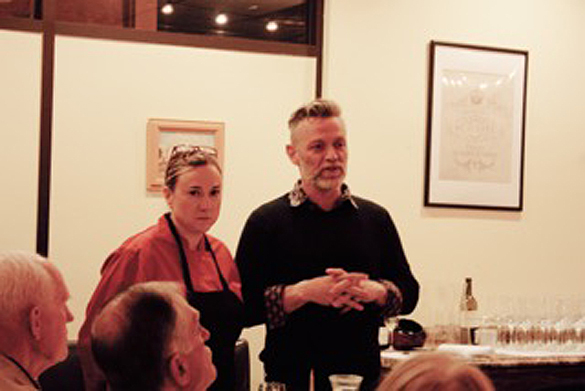 Owner/chef Laura Crucet Hamilton with winemaker Matthew Rorick. Photo by Mandy Marksteiner
Owner/chef Laura Crucet Hamilton with winemaker Matthew Rorick. Photo by Mandy Marksteiner By MANDY MARKSTEINER
Los Alamos
Owner/chef Laura Crucet Hamilton hosted a winemaker’s dinner Jan. 21, at her Pig + Fig Café in White Rock that featured Matthew Rorick, the winemaker from Forlorn Hope Winery.
The menu included unique dishes like “Wild red snapper in thai red curry consommé”, “Blueberry sea salt scone, lavender sabayon, stone fruit compote, edible violet”, and “Sea scallops, micro watercress, agave lime beurre blanc.”
The wines from Forlorn Hope were a perfect match. Before the dinner Rorick participated in a Q&A:
Marksteiner: What is the story behind the name “Forlorn Hope”?
Rorick: Before I first started making my own wines, I was making wines for a couple of larger producers in Napa and Sonoma. The Forlorn Hope wines started just as a little creative outlet. A side project that I could work on, satisfy my own curiosity about what some of these less common varieties would be like to make.
When I finally decided to take the whole project commercial and actually start selling them, I had to come up with a name for it. I asked all of my friends in the industry what they thought about the idea of using all varieties that no one had ever heard of from places in California that no one had ever heard of, and everyone thought it was a terrible idea. They told me it would never work, it would be too much work to even get them out there. It was a bad idea.
I had been reading quite a bit of historical fiction about the Napoleonic Wars. The term forlorn hope was first appropriated into English from Dutch during the Napoleonic Wars. (It’s misappropriated actually.
They didn’t bring it in with the same meaning.) In that meaning that the British gave it, a group of soldiers who volunteered to be the first to charge the enemies’ defenses when there really wasn’t a great hope of success, but people went ahead and volunteered anyway.
It just seemed like such a perfect fit for a venture that everyone told me it was a terrible idea that would never work.
Marksteiner: What made your friends think it was such a bad idea?
Rorick: Trying to convince people to taste a wine that that was made from a grape they’d neve heard of before, made by a person they’ve never heard of before is, as I discovered, quite a bit of hard work.
They were saying, “Why not just make Chardonnay and Cabernet? Everyone recognizes them and they would be so much easier to sell.”
Marksteiner: What’s wrong with just drinking (and making) Chardonnay?
Rorick: If I stuck with Chardonnay, I would probably be still working for someone else in Napa (making quite a bit of money) and making Chardonnay and Cabernet all day long. My life would be a lot quieter. There’s nothing wrong with that… I suppose. My interest in working with some of these other varieties was driven by two elements. One was that I realized that I wasn’t enjoying drinking the wines that I was making. I thought, “What the hell’s the point in that?” I wanted to change my wine making style, my philosophy in the cellar, to produce wines that I enjoyed drinking. That was the first element. The second element was that I started looking at California’s viticultural history and seeing what had been grown, and recognized as varieties well suited to California pre-Prohibition. I wanted to find out what we were growing back then and why.
Marksteiner: Were there more varieties before Prohibition, or less?
Rorick: Different varieties. There was essentially no Chardonnay. Cabernet was around but was definitely not the most interesting or the most widely planted grape. California has a strong tradition of experimentation and adopting new varieties. California was one of the first places in North America that was seen as being actually viable for Vinifera varieties.
Marksteiner: Why is California so great for wine?
Rorick: Initially it was seen as the best place in the continental US for growing Vinifera because the climate was mild enough and similar enough to the European, Mediterranean climate that you didn’t have to use the American hybrids or native American varieties. You could grow wine like the Europeans did. That was a big, big deal because you couldn’t do that on the East Coast and in the South. California was the place where you could grow whatever you wanted and it turned out great. You didn’t have any problems with excess humidity in the summer, or rot. You didn’t have too much rain in the summer. That’s why it was the most amazing place. There are a lot of other factors, like having a huge influx of population during the Gold Rush, which meant there was suddenly a huge number of people that weren’t there before, who were all more than happy to get drunk when they had money in their pocket. The demand was there. Suddenly you had all this acreage that you could plant and you had an instant customer base. You’re able to establish a fairly large industry in a really short period of time.
Marksteiner: How has your life changed since starting Forlorn Hope?
Rorick: Running a vineyard means that you are tied to an agricultural pursuit, being dependent on the vagaries of nature for your livelihood, something you have really no control over. You can’t dictate whether you get rain at all or at the wrong time or when the frosts come. In 2015, we almost lost the whole vineyard and winery to the Butte Fire. We managed to stop the fire one ridge north of us. It’s such a helpless feeling. You see just this force of nature, something you can’t really do anything about, bearing down. That would have been a major catastrophe.
Marksteiner: People buy Chardonnay because they know what it is, and maybe the waiter recommended it. And so winemakers keep making it. Why do you see this as a problem?
Rorick: People know Chardonnay, they’re comfortable with saying Chardonnay. They think, “That’s what I like and that’s all I need to know about wine. I’m only going to order Chardonnay when I go out.” The problem is that so much of that Chardonnay is grown on land that makes terrible Chardonnay, and would probably make a much better wine from a totally different variety. It’s one way in which I think we’ve done ourselves a real disservice in the United States…. This fixation with variety and insisting on knowing what variety is in this bottle of wine. As opposed to, say, the French model (although they’ve yielded to pressure to put varieties on their bottles). Before that, it had all been about region. Instead of memorizing that Chardonnay is a white grape that has these flavors and characteristics you would come to understand a region, no matter what grape was in it. You’d order a wine based on the region. That actually works better because even if they’re using different varieties, most of the wines from that region are going to be similar in body, similar in the type of acid balance that they have, the way that they present on the palate, the type of experience that they give. Chardonnay can be so different depending on where it’s from, even within California. You can have Chardonnays from the extreme Sonoma Coast that are incredibly lean, have so much acid, are low in alcohol and not very expressive. Then you have Chardonnays from further inland or further south that are big, highly alcoholic, heavily oaked. They taste nothing alike. If you say, “I like Chardonnay,” but you like one of those types and not the other, you might be handed a glass of something that you don’t like at all. Whereas if you said, “I’m really in the mood for a white wine from the Sonoma Coast,” whether it was a Chardonnay or any other white variety you were given from the Sonoma Coast, it’s probably going to have a more similar character.
Anyway, it is a bit of a rant. I wish we weren’t as fixated on varietal labeling in the US. It’s seen as being done to protect consumers but I don’t know that it really helps.
Marksteiner: Tell me about your land.
Rorick: We have some of the land in California that’s about the most interesting, to me, as I can find in terms of grape growing. Most of California has soil with volcanic seabed, lava, obsidian and granite. It’s all the result of the way that California was actually formed, uplifts, volcanic and Pacific plates scraping under the North American plate. The central valley of California, at one time, was an inland sea. We actually had the only spots in California that has limestone. There’s very little limestone in California. I know of only about three spots that have it and it was a result of that inland sea laying down, or becoming shallow and warm enough to allow for the accretion of limestone. My vineyard was down on the valley floor originally, where a big vein of that limestone formed and then it was lifted up and pushed up through a bunch of schist. It’s this really unique combination of volcanic and sedimentary rocks. You’ve got schist, topsoil, limestone subsoil actually protruding up through the vineyard all at elevation at 2000 feet. It’s this really interesting combination of things that you don’t see in California. Really exciting to get to work with that site for me. It is a soil profile that is distinctly different than anywhere else in California.
The Pig + Fig Café hosts frequent gourmet wine and beer dinners for their customers, inviting winemakers and brewers from across the country as their special guests. These dinners usually sell out right away to the people on their email mailing list. The best way to get tickets to one of these events is to visit www.pigandfigcafe.com and join their email list.
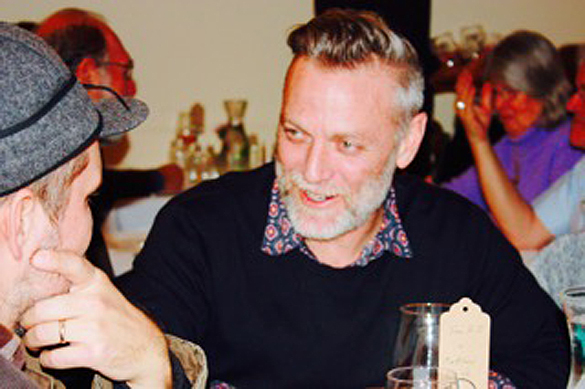 Winemaker Matthew Rorick. Photo by Mandy Marksteiner
Winemaker Matthew Rorick. Photo by Mandy Marksteiner 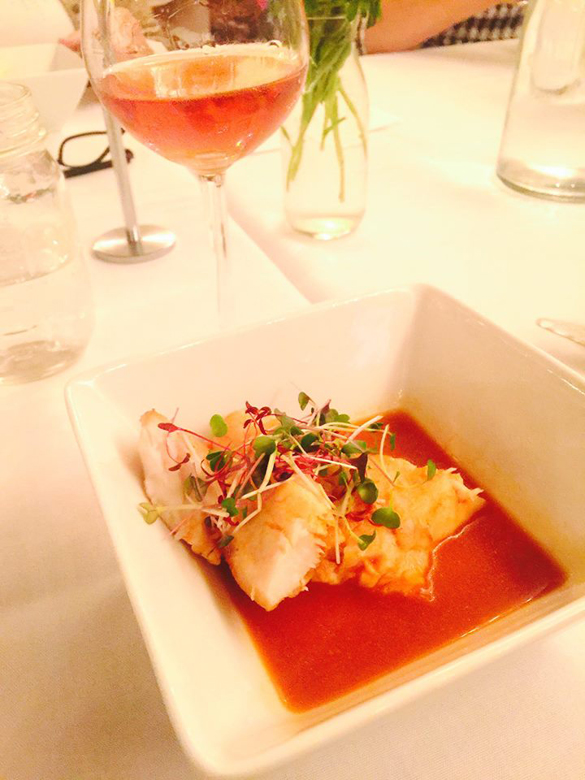 Photo by Mandy Marksteiner
Photo by Mandy Marksteiner 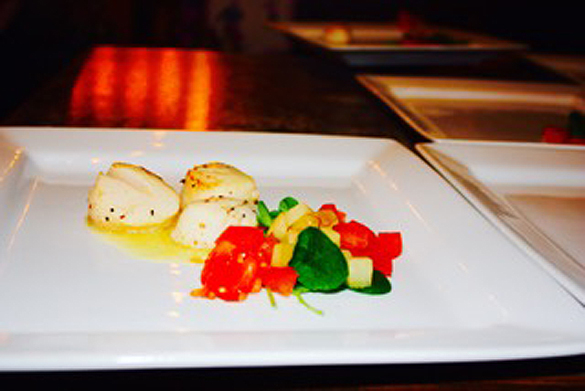 Photo by Mandy Marksteiner
Photo by Mandy Marksteiner 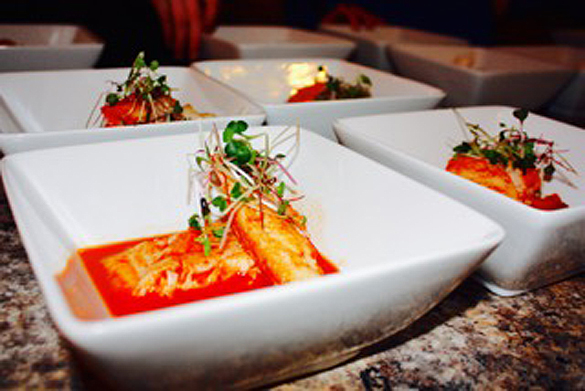 Photo by Mandy Marksteiner
Photo by Mandy Marksteiner 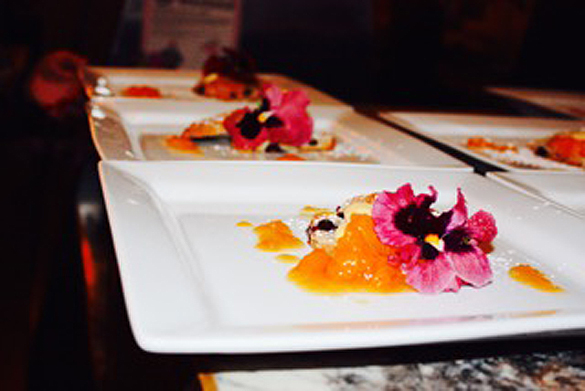 Photo by Mandy Marksteiner
Photo by Mandy Marksteiner 
